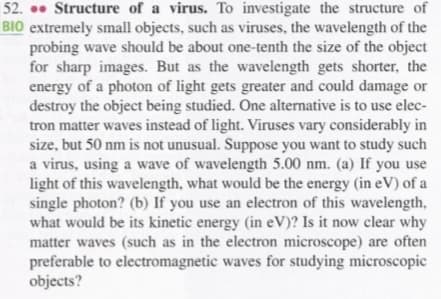a virus, using a wave of wavelength 5.00 nm. (a) If you use light of this wavelength, what would be the energy (in eV) of a single photon? (b) If you use an electron of this wavelength, what would be its kinetic energy (in ev)? Is it now clear why matter waves (such as in the electron microscope) are often preferable to electromagnetic waves for studying microscopic objects?
a virus, using a wave of wavelength 5.00 nm. (a) If you use light of this wavelength, what would be the energy (in eV) of a single photon? (b) If you use an electron of this wavelength, what would be its kinetic energy (in ev)? Is it now clear why matter waves (such as in the electron microscope) are often preferable to electromagnetic waves for studying microscopic objects?
Modern Physics
3rd Edition
ISBN:9781111794378
Author:Raymond A. Serway, Clement J. Moses, Curt A. Moyer
Publisher:Raymond A. Serway, Clement J. Moses, Curt A. Moyer
Chapter2: Relativity Ii
Section: Chapter Questions
Problem 32P
Related questions
Concept explainers
Compton effect
The incoming photons' energy must be in the range of an X-ray frequency to generate the Compton effect. The electron does not lose enough energy that reduces the wavelength of scattered photons towards the visible spectrum. As a result, with visible lights, the Compton effect is missing.
Recoil Velocity
The amount of backward thrust or force experienced by a person when he/she shoots a gun in the forward direction is called recoil velocity. This phenomenon always follows the law of conservation of linear momentum.
Question

Transcribed Image Text:52. • Structure of a virus. To investigate the structure of
BIO extremely small objects, such as viruses, the wavelength of the
probing wave should be about one-tenth the size of the object
for sharp images. But as the wavelength gets shorter, the
energy of a photon of light gets greater and could damage or
destroy the object being studied. One alternative is to use elec-
tron matter waves instead of light. Viruses vary considerably in
size, but 50 nm is not unusual. Suppose you want to study such
a virus, using a wave of wavelength 5.00 nm. (a) If you use
light of this wavelength, what would be the energy (in eV) of a
single photon? (b) If you use an electron of this wavelength,
what would be its kinetic energy (in eV)? Is it now clear why
matter waves (such as in the electron microscope) are often
preferable to electromagnetic waves for studying microscopic
objects?
Expert Solution
This question has been solved!
Explore an expertly crafted, step-by-step solution for a thorough understanding of key concepts.
Step by step
Solved in 3 steps with 6 images

Knowledge Booster
Learn more about
Need a deep-dive on the concept behind this application? Look no further. Learn more about this topic, physics and related others by exploring similar questions and additional content below.Recommended textbooks for you

Modern Physics
Physics
ISBN:
9781111794378
Author:
Raymond A. Serway, Clement J. Moses, Curt A. Moyer
Publisher:
Cengage Learning

Physics for Scientists and Engineers, Technology …
Physics
ISBN:
9781305116399
Author:
Raymond A. Serway, John W. Jewett
Publisher:
Cengage Learning

College Physics
Physics
ISBN:
9781938168000
Author:
Paul Peter Urone, Roger Hinrichs
Publisher:
OpenStax College

Modern Physics
Physics
ISBN:
9781111794378
Author:
Raymond A. Serway, Clement J. Moses, Curt A. Moyer
Publisher:
Cengage Learning

Physics for Scientists and Engineers, Technology …
Physics
ISBN:
9781305116399
Author:
Raymond A. Serway, John W. Jewett
Publisher:
Cengage Learning

College Physics
Physics
ISBN:
9781938168000
Author:
Paul Peter Urone, Roger Hinrichs
Publisher:
OpenStax College

College Physics
Physics
ISBN:
9781305952300
Author:
Raymond A. Serway, Chris Vuille
Publisher:
Cengage Learning

College Physics
Physics
ISBN:
9781285737027
Author:
Raymond A. Serway, Chris Vuille
Publisher:
Cengage Learning

University Physics Volume 3
Physics
ISBN:
9781938168185
Author:
William Moebs, Jeff Sanny
Publisher:
OpenStax